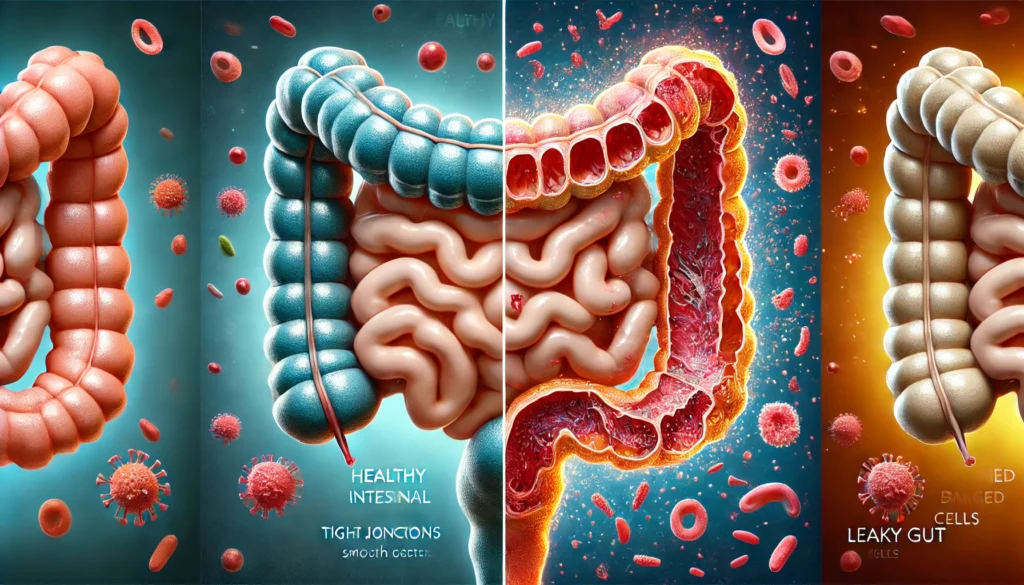Introduction
In recent years, the gut has emerged as one of the most influential systems in the human body, affecting not only digestion but also immunity, inflammation, brain function, and chronic disease risk. Yet, for millions struggling with vague symptoms like bloating, fatigue, brain fog, or autoimmune flares, the root cause may lie hidden in a compromised intestinal barrier—a condition commonly referred to as leaky gut syndrome. This increasingly discussed condition is gaining traction in both integrative and mainstream medical communities due to its links to chronic inflammation and immune dysfunction. Despite its prevalence, many individuals are unaware that the foods they eat every day may be contributing to the breakdown of their gut lining.
You may also like: How to Stop Cognitive Decline: Science-Backed Steps for Prevention and Brain Longevity
Understanding how to heal leaky gut syndrome naturally has become an urgent priority for many who seek relief from unexplained symptoms. Central to this healing process is adopting a comprehensive gut healing diet, supported by the latest research on gut barrier integrity, intestinal permeability, and food-based inflammation. This article explores what science currently says about gut lining repair, the role of gut healing foods, and how a properly structured leaky gut diet can restore balance and promote long-term gastrointestinal and systemic health. From the mechanisms of the gut barrier to practical strategies for dietary healing, this article offers a full-spectrum, evidence-informed guide on how to support your digestive system and overall health through food and lifestyle intervention.

Understanding Leaky Gut: The Science Behind the Syndrome
Leaky gut syndrome, medically referred to as increased intestinal permeability, describes a state in which the lining of the small intestine becomes damaged, allowing undigested food particles, toxins, and microbes to leak through the intestinal wall into the bloodstream. This breach in the gut barrier activates the immune system and promotes widespread inflammation, potentially leading to autoimmune conditions, skin issues, neurological symptoms, and chronic fatigue.
The intestinal lining is composed of a single layer of epithelial cells connected by tight junctions, which act as gatekeepers to control what passes into the bloodstream. When these junctions become loose or dysfunctional, the barrier becomes compromised. Environmental triggers such as chronic stress, alcohol, nonsteroidal anti-inflammatory drugs (NSAIDs), and, notably, poor dietary choices can all disrupt these junctions and lead to permeability.
Certain foods that cause leaky gut, such as refined sugars, artificial additives, gluten, and excess alcohol, can erode the gut lining or provoke an immune reaction that inflames the mucosal surface. Additionally, low levels of beneficial gut bacteria—a condition known as dysbiosis—further exacerbate inflammation and barrier dysfunction. This is why implementing a science-backed gut healing diet is essential in addressing not only the root cause but also the cascade of downstream effects.

The Role of a Gut Healing Diet in Rebuilding the Intestinal Lining
Healing a leaky gut is not about temporary restriction or elimination alone—it involves intentional, nourishing, and consistent eating patterns that rebuild tissue integrity, reduce inflammation, and support microbiome diversity. A well-designed gut healing diet provides nutrients that fuel cellular regeneration and strengthen tight junctions, such as zinc, L-glutamine, omega-3 fatty acids, vitamin A, and polyphenols.
Unlike fad detoxes, the most effective gut healing strategies are deeply rooted in whole food nutrition, emphasizing minimally processed, anti-inflammatory, and microbiota-supportive foods. These include bone broths, fermented vegetables, wild-caught fish, leafy greens, berries, and prebiotic-rich plant fibers. Collectively, these gut healing foods are rich in amino acids, bioactive compounds, and fiber that modulate inflammation and help repair stomach lining damage at a cellular level.
Importantly, consistency is key. Unlike pharmaceutical interventions that may show effects quickly, dietary gut repair requires time and adherence. By removing aggravating agents and incorporating restorative elements, a leaky gut diet sets the foundation for rebuilding intestinal architecture, reducing systemic immune activation, and restoring energy, mood, and metabolic balance.
The Key Components of an Effective Leaky Gut Diet
A medically-sound leaky gut diet focuses on removing irritants while simultaneously adding in healing foods. The first principle involves identifying and eliminating foods that commonly trigger gut inflammation. This includes gluten-containing grains, industrial seed oils, excess sugar, conventional dairy (especially for those with sensitivity), processed meats, alcohol, and artificial sweeteners. These are among the top foods to avoid with leaky gut due to their impact on tight junction proteins and inflammatory markers.
The second principle involves enriching the diet with gut healing foods that soothe, repair, and protect the gut lining. These include foods high in collagen and gelatin, such as bone broth, which provide amino acids like glycine and proline that support mucosal repair. Omega-3-rich foods such as wild salmon and flaxseeds reduce inflammation, while prebiotic-rich vegetables like onions, garlic, leeks, and asparagus promote the growth of beneficial bacteria.
Probiotic foods like sauerkraut, kimchi, kefir, and yogurt (when tolerated) help replenish good bacteria, while antioxidant-rich berries, cruciferous vegetables, and green tea provide protective phytonutrients. Adding these functional foods into an intense gut diet protocol promotes mucosal immunity, optimizes nutrient absorption, and rebalances the gut-brain axis—often restoring energy levels and cognitive function within weeks.

Foods That Cause Leaky Gut and Why They Matter
In the journey to gut health, understanding what not to eat is just as important as understanding what to include. Foods that cause leaky gut exert their harmful effects either through direct irritation of the gut lining or by disturbing microbial balance. Gluten is one of the most studied culprits, especially in individuals with celiac disease or non-celiac gluten sensitivity. It has been shown to trigger the release of zonulin, a protein that regulates intestinal permeability.
Refined sugars not only fuel pathogenic bacteria and yeast overgrowth but also promote systemic inflammation and insulin resistance, both of which impair gut function. Industrial seed oils high in omega-6 fatty acids, such as soybean, corn, and canola oils, skew the inflammatory balance in the body and impair mucosal immunity. Artificial sweeteners such as sucralose and aspartame have been shown to negatively alter gut flora, potentially increasing permeability.
For some individuals, conventional dairy products may also be problematic due to the presence of A1 casein and lactose, both of which can be difficult to digest and inflammatory. The link between dairy and leaky gut varies by individual, but the concept of dairy leaky gut sensitivity is especially relevant for those with autoimmune conditions or frequent digestive complaints. Removing these triggers allows the gut time to heal and reduces the ongoing burden on immune defenses.
How to Repair Stomach Lining Naturally: Nutrients That Matter
Natural stomach lining repair relies heavily on targeted nutrients that facilitate cellular regeneration and anti-inflammatory signaling. Among the most important is L-glutamine, an amino acid that serves as fuel for enterocytes—the cells lining the intestinal wall. Supplementation with L-glutamine has been shown to improve barrier function and reduce intestinal inflammation in both animal and human studies.
Zinc carnosine, another evidence-backed compound, helps protect against damage to the gut lining and may be especially beneficial for those recovering from NSAID use or infections. Omega-3 fatty acids from fish oil reduce inflammation in the gut mucosa, while vitamin A supports the integrity of mucosal surfaces and enhances immune tolerance.
Polyphenols, found in foods like green tea, berries, olive oil, and turmeric, help regulate tight junction proteins and protect against oxidative stress. Collagen peptides and bone broth contain glycine, proline, and hydroxyproline, which are foundational for rebuilding damaged gut tissue. These nutrients form the core of any serious gut healing diet and provide a natural, sustainable approach to improving gut integrity over time.
Building an Intense Gut Diet: When and Why to Go Deeper
In more severe cases—such as those involving autoimmune diseases, multiple food sensitivities, or long-standing gut dysfunction—a more intense gut diet may be necessary. This approach typically begins with a short-term elimination phase to identify trigger foods, followed by strategic reintroduction guided by symptom tracking and lab markers. The goal is not long-term restriction, but rather to reset and rebuild the gut so that more diverse foods can eventually be reintroduced without issue.
An intense gut diet might also incorporate functional food concentrates, herbal antimicrobials, or gut-directed therapies like butyrate, berberine, or quercetin under professional supervision. These additions can further reduce intestinal inflammation, promote healthy bacteria, and support tight junction repair. Clinical evidence supports the use of such protocols in managing not only gut issues but also skin conditions, joint pain, mood disorders, and metabolic dysfunction—all of which can be tied back to gut permeability.
Personalization remains crucial. While a general leaky gut syndrome diet provides a broad framework, tailoring it to individual sensitivities, preferences, and medical history ensures lasting success. Partnering with a qualified healthcare practitioner can help ensure that an intense gut healing strategy is both safe and effective.

Dairy, Leaky Gut, and Individual Tolerance
Dairy remains one of the most controversial foods in the context of gut health. While some individuals tolerate fermented and grass-fed dairy products well, others experience bloating, diarrhea, skin breakouts, or fatigue shortly after consumption. The term dairy leaky gut often emerges in patient discussions where eliminating dairy has led to significant improvements in digestive symptoms, energy levels, and skin clarity.
The A1 casein protein found in most conventional dairy can be inflammatory for some people, particularly those with a genetic sensitivity. Moreover, lactose intolerance can increase gut fermentation and lead to dysbiosis, further compromising gut integrity. Conversely, A2 dairy products or fermented dairy like kefir and yogurt made from goat or sheep milk may be tolerated and even beneficial due to their probiotic content.
Determining your dairy tolerance often requires a trial elimination and mindful reintroduction. Keeping a detailed symptom log during this period helps you assess the impact of dairy on your gut function, inflammation levels, and mood. For many, eliminating or modifying dairy intake becomes a cornerstone of their broader gut healing journey.
Lifestyle Factors That Support Gut Healing
While diet is undeniably the centerpiece of gut healing, lifestyle factors also play a vital role in the regeneration of the intestinal barrier. Chronic stress, sleep deprivation, overexercising, and environmental toxins all contribute to leaky gut by weakening immunity and increasing inflammatory cytokines. Mind-body practices like meditation, yoga, breathwork, and nature exposure help to reduce stress-induced permeability.
Adequate sleep supports circadian rhythm and mucosal immunity, while gentle movement like walking or tai chi improves gut motility and microbial diversity. Avoiding unnecessary antibiotic use and reducing exposure to pesticides, plastics, and processed foods also creates a cleaner internal environment for healing. Hydration supports mucosal secretions and detoxification, while regular bowel movements help prevent toxic build-up.
In this way, a comprehensive healing protocol blends dietary precision with lifestyle mindfulness. Together, they help you create an internal environment conducive to cellular repair, immune modulation, and long-term wellness.
Frequently Asked Questions
1. What is a gut healing diet and how does it work?
A gut healing diet is a structured nutritional plan designed to repair the intestinal lining, reduce inflammation, and restore microbial balance. It works by eliminating inflammatory and disruptive foods while adding nutrient-dense, anti-inflammatory, and microbiota-supportive foods. By providing the building blocks necessary for tissue repair, regulating immune responses, and supporting digestion, the gut healing diet becomes a powerful tool for restoring gastrointestinal health. Over time, this dietary approach can reduce symptoms like bloating, fatigue, brain fog, and food sensitivities that are often associated with leaky gut syndrome.
2. How do gut healing foods help rebuild the stomach lining?
Gut healing foods are rich in compounds like L-glutamine, collagen, zinc, and antioxidants that directly support the cells lining the intestines. These foods help reduce inflammation, promote tissue regeneration, and strengthen tight junctions between cells. For example, bone broth contains gelatin and amino acids essential for mucosal repair, while polyphenol-rich berries offer protection against oxidative damage. Fermented foods introduce beneficial microbes, improving microbial diversity and immune regulation. The consistent inclusion of these foods in your daily meals promotes long-term restoration of gut function.
3. What are the most important foods to avoid with leaky gut?
The most important foods to avoid with leaky gut include gluten, refined sugars, processed foods, artificial sweeteners, conventional dairy, and alcohol. These substances either damage the gut lining directly, feed harmful bacteria, or provoke immune reactions that exacerbate inflammation. Industrial seed oils and processed meats are also problematic due to their inflammatory profiles. Avoiding these foods reduces the burden on the digestive system and allows the gut lining to regenerate without interference, making it easier to heal leaky gut syndrome naturally.
4. Can I follow an intense gut diet on my own, or should I work with a specialist?
While many people begin a gut healing journey on their own using online resources and elimination diets, an intense gut diet is best undertaken with the guidance of a healthcare professional. This is especially true for individuals with multiple food sensitivities, autoimmune disorders, or long-standing digestive issues. A practitioner can help you personalize your approach, monitor progress, interpret lab results, and recommend advanced therapies. Personalized support ensures that your gut healing plan is safe, sustainable, and effective over the long term.
5. How long does it take to heal leaky gut syndrome naturally?
The time it takes to heal leaky gut syndrome naturally varies depending on the severity of the condition, adherence to the protocol, and individual biology. Some individuals notice significant symptom improvement within a few weeks, while others may require several months of consistent dietary and lifestyle changes. Factors like stress management, sleep quality, and toxin exposure also influence healing speed. By sticking to a comprehensive gut healing diet and supporting your body holistically, most people can expect to see meaningful improvements in three to six months.
6. Is there a connection between dairy and leaky gut?
Yes, there is a potential connection between dairy and leaky gut, especially in individuals who are sensitive to A1 casein or lactose. These components can irritate the gut lining, disrupt microbial balance, and contribute to inflammation. While some individuals tolerate fermented dairy or A2 dairy products, others experience digestive distress and systemic symptoms after consuming conventional dairy. If you suspect dairy may be contributing to your symptoms, an elimination period followed by structured reintroduction can help you assess your personal tolerance and guide dietary decisions.
7. What supplements support natural stomach lining repair?
Several supplements support natural stomach lining repair, including L-glutamine, zinc carnosine, omega-3 fatty acids, collagen peptides, and vitamin A. These nutrients help reduce inflammation, support cell regeneration, and strengthen the mucosal barrier. Additionally, prebiotic fibers and probiotics can enhance microbial balance, which is critical for maintaining gut integrity. While supplements can be helpful, they should complement—not replace—a diet rich in whole, gut healing foods. Always consult a healthcare provider before beginning new supplements, especially if you have underlying health conditions.
8. Can gut healing diets help with autoimmune diseases?
Emerging research suggests that gut healing diets may help manage autoimmune diseases by reducing systemic inflammation and restoring immune tolerance. Since increased intestinal permeability is often present in autoimmune conditions, healing the gut can reduce the antigenic load on the immune system. By eliminating trigger foods and enhancing mucosal immunity through diet, many individuals experience reduced flare-ups, improved energy, and better overall health. While diet alone is not a cure, it is a foundational component of many integrative autoimmune management strategies.
9. What role does stress play in leaky gut syndrome?
Chronic stress plays a significant role in the development and persistence of leaky gut syndrome. Stress hormones like cortisol can weaken tight junction proteins, disrupt gut microbiota, and suppress immune function, all of which contribute to increased permeability. Moreover, stress can impair digestion and nutrient absorption, compounding the issue. Mind-body practices such as mindfulness, yoga, and deep breathing can significantly support gut healing by mitigating the physiological effects of stress. Incorporating these practices into your daily routine enhances the effectiveness of a leaky gut syndrome diet.
10. Are there early signs that a leaky gut diet is working?
Early signs that a leaky gut diet is working include reduced bloating, more regular bowel movements, improved energy levels, clearer skin, and enhanced mood. Cognitive improvements like less brain fog and better focus are also common. Over time, individuals may notice fewer food sensitivities, reduced joint pain, and improved immune resilience. These changes indicate that the gut barrier is healing, inflammation is decreasing, and the body is moving toward balance. Staying consistent and tracking symptoms can help reinforce progress and motivate continued adherence to the plan.

Conclusion
Healing the gut is more than a trendy health pursuit—it is a scientifically backed strategy for improving digestion, reducing inflammation, and supporting long-term wellness. As research into intestinal permeability deepens, the importance of a targeted gut healing diet becomes increasingly clear. By removing foods that cause leaky gut and focusing on nutrient-dense gut healing foods, individuals can repair stomach lining damage and restore balance from the inside out.
Understanding how to heal leaky gut syndrome naturally involves more than symptom management—it’s a return to dietary roots that prioritize real food, mindful eating, and systemic harmony. Whether you are just starting or refining your gut healing journey, a carefully structured leaky gut diet offers a clear, evidence-informed path forward. Empowered by knowledge and guided by science, your gut can truly become the foundation of lasting vitality and health.
Was this article helpful? Don’t let it stop with you. Share it right now with someone who needs to see it—whether it’s a friend, a colleague, or your whole network. And if staying ahead on this topic matters to you, subscribe to this publication for the most up-to-date information. You’ll get the latest insights delivered straight to you—no searching, no missing out.
Further Reading:
Why Is My Butt Leaking? Understanding Rectal Leakage, Leaky Bowels, and What Causes Anal Seepage



